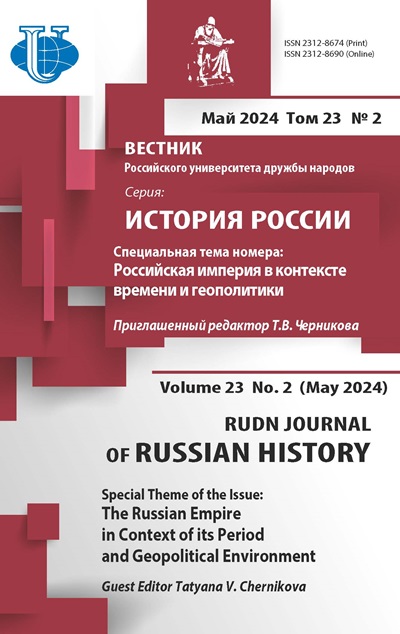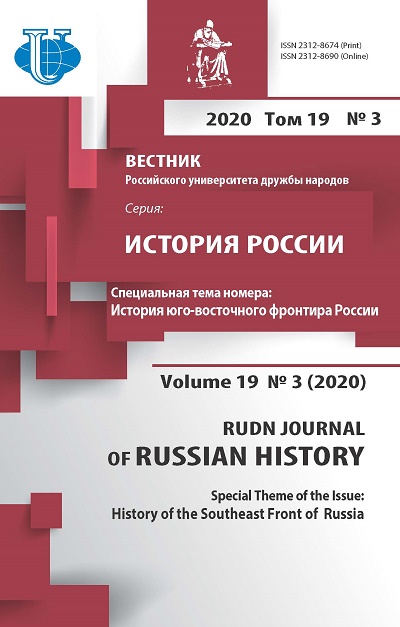Образовательная и просветительная работа среди взрослого нерусского населения Оренбургского края в конце XIX - первой трети XX века
- Авторы: Алешина С.А.1, Петрич Л.В.1
-
Учреждения:
- Оренбургский государственный педагогический университет
- Выпуск: Том 19, № 3 (2020): ИСТОРИЯ ЮГО‐ВОСТОЧНОГО ФРОНТИРА РОССИИ
- Страницы: 612-624
- Раздел: ИСТОРИЯ ЮГО‐ВОСТОЧНОГО ФРОНТИРА РОССИИ
- URL: https://journals.rudn.ru/russian-history/article/view/24451
- DOI: https://doi.org/10.22363/2312-8674-2020-19-3-612-624
Цитировать
Полный текст
Аннотация
В статье ставится проблема раскрыть просветительную и образовательную работу среди взрослого нерусского населения Оренбуржья в период с конца XIX века и вплоть до конца 1930-х гг. В статье дается краткий историографический обзор, а также источниковая база исследования. Начало статьи предваряет анализ данных Первой всеобщей переписи населения 1897 г., что дает материал для размышления по поводу глубины задач, связанных с последующим просвещением нерусских национальностей губернии. Характеризуя дореволюционный этап, не вызывает сомнения роль органов местного самоуправления в культурно-просветительной работе среди нерусского населения губернии. Среди нерусского населения проводились народные чтения, устраивались библиотеки, вечерние курсы. Земства проводили серьезную работу по подготовке квалифицированного педагогического персонала для обучения нерусских народностей. Кроме того, культурно-просветительной работой занимались общественные организации и частные лица. В годы Советской власти просветительной работе был придан политический акцент. Вся просветительная деятельность проводилась с помощью чрезвычайных методов, так как новой власти нужно было грамотное население в сжатые сроки и с минимальными затратами. Государство, в силу трудностей, связанных с Гражданской войной и голодом, переложила всю финансовую нагрузку по обучению населения на общественные организации и частные лица. В начале 1920-х гг. с связи с указанными трудностями просветительная работа в губернии практически прекратилась, к середине 1920-х годов народное хозяйство восстанавливается, просветительная работа возобновляется. На рубеже 1920-1930-х гг. просветительная работа велась при помощи чрезвычайных кампаний. Следующий значимый этап ликвидации неграмотности среди нерусского населения пришелся на середину - вторую половину 1930-х гг. Таким образом, можно сделать вывод, что и в дореволюционный, и в советский период работа по обучению нерусского населения сопровождалась определенными трудностями, а именно нехваткой средств, квалифицированных кадров, непониманием необходимости учиться среди местного населения.
Об авторах
Светлана Александровна Алешина
Оренбургский государственный педагогический университет
Автор, ответственный за переписку.
Email: ospu@ospu.ru
кандидат педагогических наук, ректор
460000, Россия, Оренбург, ул. Советская, 19Лариса Владимировна Петрич
Оренбургский государственный педагогический университет
Email: Lorapavlova@list.ru
кандидат исторических наук, доцент кафедры истории России
460000, Россия, Оренбург, ул. Советская, 19Список литературы
- Баканов С.А. О темпах ликвидации неграмотности в Казахстане в 1926-1939 годах // Вопросы истории. 2002. № 8. С. 142-145.
- Богданов И.М. Грамотность и образование в дореволюционной России и в СССР: (Историкостатистические очерки). М.: Статистика, 1964. 195 с.
- Васильев Д.В., Любичанковский С.В. Казахи и русские: бытовая аккультурация в XIX в. // Вопросы истории. 2018. № 3. С. 151-165.
- Владыкина В.А. Концептуальные проблемы национального образования в Советской России (1920-1930-е гг.) // Педагогика. 2000. № 10. С. 71-75.
- Жиромская В.Б. Демографическая история России в 1930-е гг. Взгляд в неизвестное. М.: «Российская политическая энциклопедия» (РОССПЭН), 2001. 280 с.
- Любичанковский С.В. Образовательная политика Российской империи и формирование казахской интеллигенции на территории Оренбургского края во второй XIX века // Самарский научный вестник. 2018. Т. 7. № 4. С. 245-249
- Любичанковский С.В. Политика аккультурации средствами просвещения исламских подданных Российской империи: исторический опыт Оренбургского края (середина XIX - начало XX вв.). Оренбург: Издательский центр ОГАУ, 2018. 264 с
- Любичанковский С.В. «Инородческое образование» на Южном Урале как предмет изучения региональной историографии (1869-2004) // Известия Самарского научного центра Российской академии наук. Исторические науки. 2019. Т. 1. № 1. С. 99-104
- Моргунов К.А. Исторический опыт государственного регулирования национальных отношений на Южном Урале (1917-1939 гг.). Оренбург: Оренбургский государственный педагогический университет, 2000. 279 с.
- Петрич Л.В., Любичанковский С.В. Уровень грамотности взрослого населения Оренбуржья по материалам первых советских переписей // Самарский научный вестник. 2017. Т. 6. № 3. С. 242-246.
- Сафарова А.Д. Развитие образования национальных меньшинств в Оренбургском крае (конец XIX века - 1940 г.). Оренбург: Оренбургский государственный педагогический университет, 2009. 186 с.
- Сафронов А.А. Первая всеобщая перепись населения России 1897 г.: разработка данных о грамотности, их информационный потенциал и достоверность // Документ. Архив. История. Современность. Екатеринбург: Уральский университет, 2003. С. 203-219
- Серебренников Ю.Н. Уровень грамотности и образования населения Урала (1861-1917 гг.). Оренбург: Оренбургский государственный педагогический университет, 1998. 166 с
- Сивоволов Д.Ф., Юсупов М.Р. Культурно-просветительная деятельность земств Урала (1864 - февраль 1917 г.). Челябинск: ЧВВАККИУ, 2008. 156 с
- Цибульский Н.Б. Работа по ликвидации неграмотности среди национальных меньшинств в Челябинской области в 1930-е годы // Двенадцатые Бирюковские чтения: Тезисы научнопрактической конференции. Челябинск: [Б.и.], 1996. C. 69-71
- Цибульский Н.Б. Новый этап движения за всеобщую грамотность в Челябинской области во второй половине 30-х годов // Проблемы социально-экономического и политического развития Урала в XVIII-XX веках. Челябинск: Челябинский государственный университет, 1997. C. 159-169
- Akanov K.G., Lyubichankovsky S.V. Orenburg in the History of Integration of Kazakh Steppe in the Russian Imperia XVIII - beginning of XX century // Bylye Gody. 2018. Vol. 48. № 2. P. 484-495
















